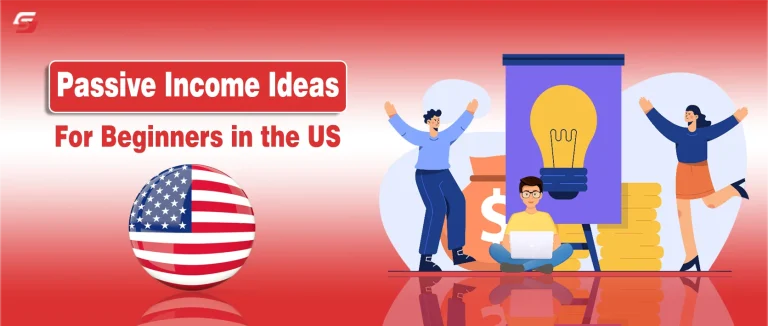The idea of making money without doing anything has become very appealing in today’s fast-paced financial world. It promises to make money without much work all the time, and people can use this to get financial freedom and flexibility.
However, one must understand that passive income can be very profitable, but it can also require a lot of work and money up front. The guide will look at the different ways to make passive income, including those that are better for beginners in the US. It will also talk about the risks and rewards of passive income and how to get started on each path.
1. Real Estate Investments for Passive Income in the US
One of the best ways to make money without working in the US is through real estate. It gives you monthly rental income, long-term value growth, and tax breaks. People who are just starting out can build wealth without having to do anything on a daily basis by investing in rental properties or REITs (Real Estate Investment Trusts).
There are three main ways that people in the US make money from real estate: rent, appreciation, and REIT dividends.
- Rental Income: Get regular monthly payments from your tenants.
- Value of property goes up over time, especially in states that are growing quickly, like Florida, Texas, and California.
- REIT dividends: Get money from a variety of professionally managed property portfolios.
Result: A combination of steady monthly returns and long-term wealth growth from tangible assets.
Getting Started: Rental Properties vs. REITs
1. Rental Properties
- You can buy a single-family home, a duplex, or a small apartment.
- Before you buy, look at the local rental market, safety, and job growth.
- Use mortgage financing wisely to keep your cash flow positive.
- For real passive income, hire someone else to manage your property.
2. Real Estate Investment Trusts (REITs)
- Put money into publicly traded companies that own or lend money for real estate.
- Get to know the residential, commercial, and industrial sectors.
- Use brokerage accounts or IRAs to make small investments at first.
- Enjoy cash flow without having to take care of repairs or tenants.
Tip: Start with REITs to learn the real estate market before buying physical property.
Benefits | Appreciation, Tax Deductions, and Inflation Protection
Real estate offers both cash flow and wealth-building potential unmatched by many other passive income sources.
- Appreciation: Property values generally rise over time.
- Tax Advantages: Deduct mortgage interest, depreciation, and maintenance costs under IRS rules.
- Stable Monthly Returns: Reliable rent payments create consistent passive income.
- Inflation Hedge: Property values and rent typically increase with inflation.
Risks | Market Swings, Costs, and Tenant Management
Even strong real estate markets carry practical risks for beginners.
- Market Volatility: Recessions can lower property values and rental demand.
- Maintenance Expenses: Repairs and upgrades cut into returns.
- Tenant Challenges: Vacancies, late payments, or damages disrupt income.
- Low Liquidity: Properties take months to sell compared to stocks.
Pro Tip: Keep a maintenance reserve and diversify with REITs to reduce exposure.
REITs vs. Direct Ownership | What’s Better for Beginners?
| Criteria | REITs | Direct Property Ownership |
| Initial Investment | Low – shares from a few dollars | High – needs down payment & closing costs |
| Management Responsibility | None – handled by professionals | Full – tenants, repairs, taxes |
| Liquidity | High – easily traded on exchanges | Low – slower to sell |
| Returns | Moderate, consistent dividends | Variable – depends on market & occupancy |
| Tax Benefits | Limited to dividend deductions | Full property-related deductions |
REITs are best for beginners seeking low-cost entry and liquidity. Direct ownership offers higher potential and control but demands capital, effort, and management.
2. Dividend Stocks and ETFs
In the US, dividend stocks and ETFs are two of the easiest ways to make money without doing anything. They give out regular cash dividends from profits or fund distributions. ETFs spread investments across many industries, giving investors steady income, compound growth, and long-term stability.
Investing in dividends means that companies pay shareholders cash on a regular basis, which is a form of passive income. A dividend stock is a type of stock that gives you a share of a company’s profits. A dividend ETF is a fund that holds shares in several companies that pay dividends. It balances performance across sectors like finance, utilities, healthcare, and consumer goods.
Core mechanisms of dividend income:
- Companies declare dividends based on profits and payout ratios.
- Shareholders receive direct deposits into brokerage accounts.
- Dividend Reinvestment Plans (DRIPs) automatically reinvest payouts to buy more shares and accelerate compounding.
Top-performing US ETFs such as Vanguard Dividend Appreciation ETF (VIG) and Schwab U.S. Dividend Equity ETF (SCHD) provide diversified exposure and consistent yields. Dividend investing lets beginners earn regular income without active trading or complex management.
Getting Started: Selecting Reliable Dividend Stocks and ETFs
US investors can begin dividend investing by focusing on financially stable companies and diversified ETFs with proven payment consistency. Reliable dividend assets combine growth potential with lower risk.
Steps to start investing:
- Open a brokerage account (e.g., Fidelity, Charles Schwab, or Robinhood).
- Research payout history, target companies with 5+ years of dividend growth.
- Evaluate dividend yield (2–5%) and payout ratio (<70%) for sustainability.
- Choose dividend-focused ETFs for automatic diversification.
- Reinvest dividends to enhance compounding.
Examples of reliable dividend assets:
- Coca-Cola (KO): Consumer goods giant with 50+ years of dividend increases.
- Johnson & Johnson (JNJ): Healthcare leader with consistent payouts.
- Vanguard High Dividend Yield ETF (VYM): Tracks high-yielding US companies.
Tip: Diversify across sectors to stabilize income and minimize volatility.
Benefits: Compound Growth and Long-Term Financial Security
Dividend stocks and ETFs offer several quantifiable advantages for passive income investors in the US:
- Compound Growth: Reinvested dividends buy more shares, accelerating portfolio expansion.
- Financial Stability: Dividend-paying companies tend to have mature, resilient business models.
- Inflation Hedge: Growing dividends protect purchasing power over time.
- Lower Volatility: Dividend stocks often show steadier performance during market downturns.
- Tax Efficiency: Qualified dividends receive lower federal tax rates than ordinary income.
Risks: Market Downturns and Dividend Cuts
Dividend investing carries manageable but important risks that new investors should plan for.
- Market Downturns: Recessions can reduce profits and drive stock prices lower.
- Dividend Cuts: Companies may suspend payments during financial strain, reducing income flow.
- Sector Concentration: Overweighting one industry increases exposure to specific downturns.
- Inflation Risk: Fixed dividends may lose value during high inflation.
- Interest Rate Sensitivity: Rising rates can make bonds more attractive, temporarily lowering demand for dividend stocks.
Pro Tip: Diversify across sectors and include a mix of ETFs and individual stocks to maintain steady income during market volatility.
3. High-Yield Savings Accounts and Certificates of Deposit (CDs)
In the US, the safest ways to make passive income are high-yield savings accounts and CDs. They have guaranteed returns, FDIC insurance, and no exposure to the market, making them perfect for beginners who want steady income instead of high risk.
- High-yield savings accounts earn interest on deposits without market volatility.
- Offered mainly by online banks like Ally Bank, Marcus by Goldman Sachs, and Discover Bank.
- FDIC or NCUA insurance protects deposits up to $250,000 per person, per institution.
- Interest compounds daily, paid monthly, offering reliable passive cash flow.
Good for: Stable returns and emergency fund storage
Not ideal for: High-growth or inflation-beating returns
Getting Started: Best Online Banks & Rate Comparison
How to begin:
- Open an FDIC-insured account with a reputable online bank.
- Compare APYs — currently 4.00%–5.25% for savings and 4.50%–5.50% for CDs.
- Use automatic transfers to grow savings consistently.
- Choose CD terms based on your liquidity needs — 6, 12, or 24 months typical.
| Bank / Institution | Account Type | Approx. APY | Insurance | Access |
| Ally Bank | Online Savings | ~4.20% | FDIC | Instant |
| Marcus by Goldman Sachs | High-Yield Savings | ~4.40% | FDIC | Instant |
| Discover Bank | CDs / Savings | 4.30–5.40% | FDIC | Fixed term |
Tip: Online banks usually offer better rates due to lower operating costs.
Benefits: Low Risk and FDIC Protection
- Principal Safety: Fully insured deposits up to $250,000.
- Guaranteed Earnings: Fixed-rate CDs ensure predictable returns.
- High Liquidity: Easy withdrawals from savings accounts.
- Effort-Free Growth: No market monitoring or management needed.
- Flexible Terms: Ideal for short-term savings or income stability.
Reliable income stream with zero chance of capital loss.
Limitations: Low ROI vs. Other Investments
- Lower Returns: Even top APYs rarely exceed 5%, often below inflation.
- Opportunity Cost: Locked funds in CDs can’t be used for higher-yield assets.
- Early Withdrawal Penalties: CD cash-outs before maturity reduce earnings.
- No Capital Growth: Unlike stocks or ETFs, returns don’t compound through asset appreciation.
Best used as a safe parking option, not a long-term wealth builder.
4. Peer-to-Peer Lending Platforms
Peer-to-peer (P2P) lending platforms let US investors make money without doing anything by lending money directly to people who need it online.
Prosper, LendingClub, and Upstart are all platforms that offer higher returns than savings accounts, but they also come with the risk of borrowers not paying back their loans and not having enough money to cover their expenses.
P2P lending generates passive income through interest payments made by borrowers over time. Each investor funds small portions of multiple loans, spreading risk while earning consistent returns. The platform manages loan creation, repayment, and borrower screening.
How income works:
- Borrowers repay monthly with fixed interest.
- Payments are deposited directly into investors’ accounts.
- Average annual returns range from 5% to 10% based on borrower credit grades.
- Automated reinvestment compounds returns over time.
Example: LendingClub and Prosper allow investors to reinvest repayments automatically, keeping income generation steady with minimal manual effort.
Getting Started | Popular US Platforms like Prosper and LendingClub
Beginners can start P2P investing on regulated US platforms designed for retail lenders. These marketplaces match investors with creditworthy borrowers and handle all loan servicing.
Steps to start investing:
- Open an account on Prosper, LendingClub, or Upstart.
- Verify identity and fund the investment balance.
- Choose borrower risk grades (A–E) based on desired return and tolerance.
- Diversify across 100+ loans to balance potential defaults.
- Enable auto-invest for continuous reinvestment.
Platform snapshot:
- Prosper: Offers personal loans up to $50,000 with fixed rates.
- LendingClub: Focused on debt consolidation and small business loans.
- Upstart: Uses AI-based credit scoring to reduce borrower risk.
Tip: Minimum investments start around $25 per note, making it easy to diversify without large capital.
Benefits: Higher Returns Than Savings Accounts
P2P lending provides higher yields than most traditional bank products, making it an attractive passive option for US investors.
Key benefits:
- Higher Returns: Typical returns range between 5%–10% annually.
- Steady Cash Flow: Monthly repayments ensure consistent income.
- Portfolio Diversification: Adds exposure to consumer credit markets.
- Low Entry Point: Accessible to small investors.
- Automation: Reinvestment tools increase compounding over time.
Example: A $5,000 diversified portfolio earning 7% annually can yield around $350 in yearly passive income.
Risks | Loan Defaults and Economic Downturn Impact
P2P lending involves elevated risk compared to insured savings products or bonds. Borrowers may fail to repay, and loans cannot be easily liquidated before maturity.
Main risks include:
- Loan Defaults: Loss of principal if borrowers fail to repay.
- Recession Effects: Higher unemployment leads to more defaults.
- Platform Risk: Operational issues may delay or disrupt payouts.
- Low Liquidity: Funds are tied up until loans mature.
- Inflation and Rate Impact: Rising interest rates may reduce new lending demand.
Risk Tip: Diversify across hundreds of small loans and multiple platforms to manage default exposure.
P2P Lending vs. Bonds – Which Is Safer for Beginners?
| Criteria | P2P Lending Platforms | Bonds (Corporate or Government) |
| Return Potential | 5%–10% (Higher) | 2%–6% (Moderate) |
| Risk Level | Higher – borrower defaults possible | Lower – backed by corporations or government |
| Liquidity | Low – tied until loan maturity | Moderate – tradable on markets |
| Diversification | Consumer loan exposure | Sector or government diversification |
| Capital Security | Not FDIC-insured | Backed by issuer or government |
5. Creating and Monetizing Digital Products
Digital products such as e-books, online courses, and templates allow individuals and small businesses in the US to earn passive income with minimal overhead. These assets generate continuous sales once uploaded to platforms like Gumroad, Udemy, and Etsy, which automate payments, delivery, and audience reach.
- How They Generate Income: E-books sell through Amazon or Gumroad, courses earn from student enrollments on Udemy, and templates provide steady sales on Etsy or Creative Market.
- Getting Started: Choose a niche that solves specific problems, like productivity, finance, or design, and use a platform suited to your product type.
- Key Benefits: High scalability, low costs, and global reach make digital products efficient for long-term income generation.
- Main Challenges: Market saturation and the need for consistent marketing require creators to differentiate products and maintain visibility.
- Best US Platforms:
- Gumroad: flexible pricing, best for multipurpose digital files.
- Udemy: ideal for online courses with global exposure.
- Etsy: great for design templates and creative products.
- Gumroad: flexible pricing, best for multipurpose digital files.
6. Affiliate Marketing for Passive Income
Affiliate marketing allows individuals in the US to earn commission-based passive income by promoting other companies’ products or services through referral links. It’s a scalable online income stream that rewards content creators, bloggers, and social media influencers for driving verified sales or leads.
If you’re looking for flexible income ideas you can manage from home, check out our detailed guide on freelancing jobs at home to explore beginner-friendly remote earning opportunities.
- How It Works: An affiliate partner promotes a merchant’s product using unique tracking links. When a user makes a purchase through that link, the affiliate earns a percentage of the sale.
- Getting Started: Join reputable affiliate networks such as Amazon Associates, ShareASale, or CJ Affiliate. Build content around a focused niche, like tech gadgets, finance tools, or lifestyle products, and integrate links naturally into blogs, YouTube videos, or newsletters.
- Key Benefits:
- Low startup costs and no inventory management.
- Scalability through multiple content channels.
- Potential for recurring commissions on subscription-based products.
- Low startup costs and no inventory management.
- Primary Challenges:
- High competition in popular niches.
- Dependence on search engine rankings or platform algorithms.
- Delayed payouts or fluctuating conversion rates.
- High competition in popular niches.
- Best US Platforms:
- Amazon Associates – vast product range and brand trust.
- ShareASale – thousands of merchants across industries.
- ClickBank – digital product focus with high commission potential.
- Amazon Associates – vast product range and brand trust.
7. Building a YouTube Channel for Passive Income
A YouTube channel allows creators in the US to earn passive income by monetizing video content through ads, sponsorships, and affiliate links. Once videos gain steady traffic, they continue generating revenue with minimal ongoing effort.
- How It Generates Passive Returns:
YouTube pays creators through AdSense revenue, sponsorship deals, and affiliate marketing integrations. Engaging, evergreen content, like tutorials, product reviews, or educational explainers, attracts consistent viewership and recurring ad income. - Getting Started:
- Create a Google account and launch a YouTube channel under a clear niche (tech, finance, travel, or education).
- Optimize titles, thumbnails, and descriptions for visibility.
- Reach 1,000 subscribers and 4,000 watch hours to qualify for the YouTube Partner Program.
- Diversify income by promoting products, using Patreon, or licensing video clips.
- Create a Google account and launch a YouTube channel under a clear niche (tech, finance, travel, or education).
- Benefits:
- Evergreen videos generate ongoing income even without frequent uploads.
- Multiple revenue sources: ads, affiliate links, brand sponsorships, and memberships.
- Low entry cost, only requires basic video equipment and consistency.
- Evergreen videos generate ongoing income even without frequent uploads.
- Challenges:
- High competition and algorithm dependency.
- Initial growth phase may take months before monetization.
- Requires regular uploads and viewer engagement to sustain visibility.
- High competition and algorithm dependency.
- Best US Platforms and Tools:
- YouTube Studio – analytics and content management.
- TubeBuddy and VidIQ – keyword and SEO optimization tools.
- Patreon – membership-based recurring income.
- YouTube Studio – analytics and content management.
Want to turn your creativity into income? Learn the step-by-step process in our post on how to create a YouTube channel and start building a profitable online presence today.
8. Print-on-Demand and E-commerce Automation for Passive Income in the US
Print-on-demand (POD) and e-commerce automation allow entrepreneurs in the United States to earn passive income by selling custom products online without handling inventory, shipping, or packaging. Once the store setup is complete, orders are fulfilled automatically by third-party providers, creating an ongoing, hands-free income stream.
How It Generates Passive Returns
Print-on-demand generates passive returns through automated order processing and fulfillment.
- Sellers upload custom designs to an online storefront.
- When customers place an order, the POD partner prints, packs, and ships the product.
- The seller keeps the profit margin between the base cost and retail price.
Platforms like Printful, Printify, and Gelato handle logistics, while sellers focus on design and marketing. Once listings gain consistent traffic, they continue generating sales with minimal effort.
Getting Started
Steps to launch a print-on-demand business in the US:
- Choose a niche such as fitness apparel, pet accessories, or motivational merchandise.
- Create designs using Canva, Figma, or Adobe Express.
- Connect POD providers like Printful or Printify to platforms such as Shopify, Etsy, or WooCommerce.
- Set product pricing to balance competitiveness and profit.
- Automate fulfillment, shipping, and customer notifications through integrations.
These steps help new sellers establish a fully automated online store without inventory risks.
Benefits
- Low Startup Cost: No upfront inventory or warehouse expenses.
- Automation: Printing, packaging, and delivery are handled automatically.
- Scalability: Add unlimited new products or designs with minimal extra effort.
- Global Reach: Sell 24/7 to US and international customers.
- Brand Control: Customize packaging and labels to build brand identity.
This combination of flexibility and automation makes POD one of the easiest ways for beginners to earn online income.
Challenges
- High Competition: Many sellers target similar designs or niches.
- Marketing Costs: Paid advertising or social media campaigns are often needed to drive traffic.
- Thin Margins: Production and shipping costs reduce profit per sale.
- Vendor Dependence: Product quality and delivery speed rely on third-party partners.
Sustainable results require good niche selection, creative branding, and consistent promotion.
Best US Platforms and Tools
- Printful – premium quality printing, custom branding, Shopify integration.
- Printify – large supplier network with competitive product pricing.
- Gelato – eco-friendly production with fast US and global delivery.
- Etsy + Printify – ideal for handmade or personalized product sellers.
- Shopify + Printful – best for scalable e-commerce automation.
These platforms simplify fulfillment, helping sellers focus on creative and marketing strategies.
9. Blogging and Ad Revenue for Passive Income in the US
Blogging remains one of the most reliable ways to earn passive income in the United States. A well-optimized blog can generate recurring revenue through Google AdSense, affiliate marketing, and sponsored posts. Once quality content ranks on search engines, it continues attracting organic traffic and monetizing automatically over time.
How Blogging Generates Passive Returns
Blogging generates passive income by turning web traffic into advertising and affiliate revenue.
- Ad Revenue: Google AdSense and Mediavine display ads pay per view or click.
- Affiliate Links: Bloggers earn commissions by recommending products or services.
- Sponsored Posts: Brands pay for exposure to a blog’s audience.
As blog posts gain visibility through SEO and backlinks, they continue to earn income even without new content uploads.
Getting Started
Steps to start a profitable blog in the US:
- Choose a niche with consistent search demand, such as personal finance, tech reviews, or home improvement.
- Set up a website using WordPress, Squarespace, or Wix.
- Publish high-quality, SEO-optimized articles regularly.
- Apply for Google AdSense or Ezoic once the blog reaches steady traffic.
- Use affiliate networks like Amazon Associates, ShareASale, or Impact Radius to add monetized links.
With consistent posting and SEO, blogs can achieve organic growth and long-term visibility.
Benefits
- Low Startup Cost: Only requires domain registration and basic hosting.
- Scalability: Each new post increases traffic potential and ad revenue.
- Long-Term Value: Well-ranked articles can generate income for years.
- Multiple Monetization Streams: Ads, affiliates, digital products, and email marketing.
- Creative Freedom: Bloggers choose their topics, tone, and business model.
This flexibility makes blogging ideal for individuals seeking steady, compounding income growth.
Challenges
- Slow Start: SEO growth can take months before producing steady traffic.
- Content Competition: High-ranking topics require in-depth, expert-level writing.
- Algorithm Changes: Google updates can temporarily reduce traffic and earnings.
- Maintenance: Blogs require security, updates, and occasional content refreshes.
Overcoming these challenges requires patience, niche authority, and continuous optimization.
Best US Platforms and Tools for Blogging
- WordPress.org – best for flexibility, plugins, and SEO control.
- Wix – easy drag-and-drop builder for beginners.
- Squarespace – all-in-one platform for visuals and simplicity.
- Google AdSense – easy-to-integrate advertising network.
- Mediavine – high-paying ad management for established blogs.
These tools help automate monetization and performance tracking for sustained income. If blogging interests you as a passive income stream, you’ll love our breakdown of profitable blog niche ideas to help you choose topics that generate lasting revenue.
10. Building a Royalties-Based Income Stream
Royalties provide passive income by allowing creators, inventors, and rights holders in the US to earn recurring payments when others use their intellectual property — such as books, music, patents, or digital assets. Once the asset is created and licensed, income continues to flow without additional labor.
How It Generates Passive Returns:
Royalties are payments made to owners of intellectual property (IP) each time their work is sold, streamed, or used commercially. This includes:
- Authors earning from book sales and eBook downloads.
- Musicians and producers receiving royalties from streaming and licensing.
- Inventors licensing patents or trademarks to companies.
- Digital artists selling rights to designs, stock photos, or NFTs.
These payments accumulate passively as long as the licensed work continues generating demand.
Getting Started:
- Choose your IP asset type: book, song, photo, design, software, or patent.
- Create or register your work: use the U.S. Copyright Office or USPTO for official protection.
- Distribute or license the asset: through marketplaces like Amazon KDP, Spotify, Etsy, or Getty Images.
- Track and manage royalties: via SoundExchange, ASCAP, or Royalty Exchange.
Benefits:
- Long-term recurring income from intellectual property.
- Scalable potential — one creation can earn for years.
- Ownership protection and potential for resale or inheritance.
Challenges:
- Initial creative effort and legal setup can take time.
- Royalties depend on market demand and licensing agreements.
- Legal disputes may arise if ownership rights aren’t clear.
Best US Platforms and Tools:
| Purpose | Platform / Tool |
| Book Publishing | Amazon KDP, Draft2Digital |
| Music Royalties | TuneCore, DistroKid, ASCAP |
| Image & Design Licensing | Adobe Stock, Shutterstock, Creative Market |
| Patent Licensing | Royalty Exchange, InventRight |
Conclusion | Our Take on Building Sustainable Wealth Through Smart Passive Income
As we finish this financial guide, it’s clear that making money in the US isn’t about following trends; it’s about picking the right starting points and sticking with them. We looked at some beginner-friendly options, such as affiliate marketing, dividend investing, digital products, and print-on-demand businesses. Each of these is meant to grow steadily over time with reinvestment.
The best thing we can say is to start small, learn how to make money passively from one source, and then move on to other reliable sources like royalties, real estate, or index funds. Instead of short-term gains, you should focus on scalability, automation, and long-term balance.
We think that the key to financial independence is to keep learning, reinvest wisely, and be able to adapt to changes in the economy. When we see passive income as a long-term goal instead of a quick fix, every little thing we do becomes a step toward long-term financial freedom.
FAQs | Passive Income Ideas for US Beginners in 2025
Passive income is money earned from investments, assets, or digital products that continue to generate cash flow with minimal ongoing effort.
The best beginner options include dividend stocks, real estate, high-yield savings accounts, e-commerce automation, and digital product sales.
Most passive income streams in the US can start with as little as $100 to $500, depending on the platform or investment type.
Most passive income ideas require initial setup, learning, and monitoring before they become mostly automated.
Yes, rental properties and REITs offer steady monthly returns and long-term appreciation, though they require maintenance and risk management.











